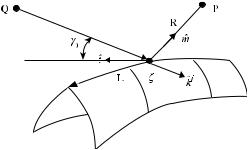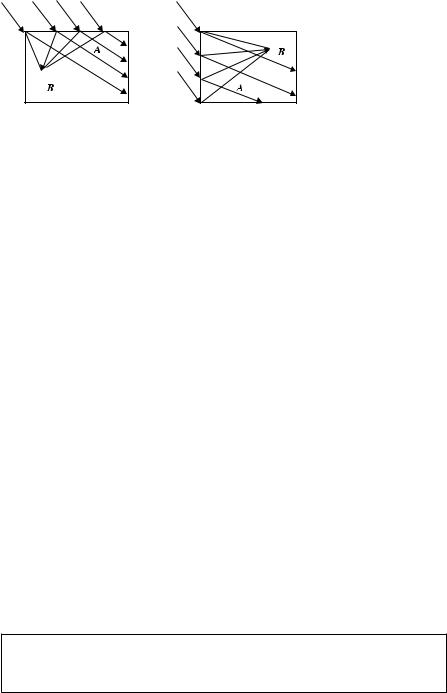
Ufimtsev P. Fundamentals of the physical theory of diffraction (Wiley 2007)(348s) PEo
.pdf
Chapter 8
Ray and Caustics Asymptotics for Edge Diffracted Waves
This chapter is based on the papers by Ufimtsev (1989, 1991).
8.1RAY ASYMPTOTICS
The following relationships exist between the acoustic and electromagnetic diffracted rays:
us = Et , if uinc(ζ ) = Etinc(ζ ); |
uh = Ht , |
if uinc(ζ ) = Htinc(ζ ), |
where ˆt is the tangent to the edge at the diffraction point |
ζ . |
|
8.1.1 Acoustic Waves
The theory of EEWs is applied here for calculation of scattering at a smoothly curved edge L with a slowly changing angle α(ζ ) between its faces (Fig. 8.1). In a small vicinity of the point ζ on the edge, an arbitrary incident field
uinc(ζ ) = u0(ζ )eikφ i (ζ ) |
(8.1) |
can be locally considered as a plane wave propagating in the direction
ki |
= |
φi |
= |
grad |
φi. |
(8.2) |
ˆ |
|
|
|
|
Therefore, replacing the quantity uinc(ζ ) in Equations (7.89) and (7.90) and Equations (7.96) and (7.97) by Equation (8.1), we obtain the asymptotic expressions
Fundamentals of the Physical Theory of Diffraction. By Pyotr Ya. Ufimtsev
Copyright © 2007 John Wiley & Sons, Inc.
213
TEAM LinG



216 Chapter 8 |
Ray and Caustics Asymptotics for Edge Diffracted Waves |
|
|
|
|||||||||||||
and |
|
|
|
|
|
|
|
|
|
|
|
|
|
|
|
|
|
|
uh(1) = −uinc(ζst )g(0)(ϕ, ϕ0, α) |
√ |
eiπ/4 |
eikR |
|
|
(8.15) |
||||||||||
|
|
|
|
|
|
|
|||||||||||
|
|
R |
|
|
|||||||||||||
|
2π k (ζst ) |
|
|
||||||||||||||
in the directions α < ϕ < 2π , related to the region inside the tangential wedge. |
|
||||||||||||||||
|
|
|
|
|
|
|
|
|
|
|
|
|
|
|
(1) |
|
(0) |
The total diffracted field us,htot radiated by the total sources j s,htot = j s,h |
+ j s,h |
||||||||||||||||
is described |
by |
Equations (8.12) |
and |
(8.13), where |
|
one |
should replace |
||||||||||
f (1)(ϕ, ϕ0, α), |
g(1)(ϕ, ϕ0, α) by functions |
f (ϕ, ϕ0, α), |
g(ϕ, ϕ0, α). In |
the |
region |
||||||||||||
α < ϕ < 2π (inside the tangential wedge), |
the total |
diffracted |
field |
u(1) |
+ |
u(0) |
|||||||||||
asymptotically equals zero, because u |
(1) |
= −u |
(0) |
|
|
|
|
|
|
|
|
|
|||||
|
|
|
in accordance with Equations (8.14) |
||||||||||||||
and (8.15). |
|
|
|
|
|
|
|
|
|
|
|
|
|
|
|
|
|
The above asymptotics for edge diffracted waves can be presented in another form that reveals their ray structure. To do this, we utilize the following differential
operations: |
|
|
|
|
|
|
|
|
|
|
|
|
|
|
|
|
|
|
|
|
|
|
|
|
|
|
|
|
|
|
|
|
|
|
||
|
= |
|
d |
= |
t |
|
|
(φinc |
+ |
R) |
= |
t |
ki |
t |
· |
R |
= − |
cos γ |
t |
R, (8.16) |
||||||||||||||||
|
dζ |
|
|
|
|
|||||||||||||||||||||||||||||||
|
|
|
|
|
ˆ · |
|
|
|
|
|
|
ˆ · ˆ |
+ ˆ |
|
0 |
+ ˆ · |
|
|||||||||||||||||||
|
|
|
d |
|
|
|
|
|
|
|
dγ0 |
|
d |
|
R |
|
|
|
|
|
dt |
|
|
|
|
|||||||||||
|
|
|
|
|
|
|
|
|
|
sin γ |
|
|
|
|
|
|
|
|
|
t |
|
R |
|
ˆ |
, |
|
|
(8.17) |
||||||||
= dζ |
|
|
= |
|
+ |
|
|
dζ |
|
|
|
|
· dζ |
|
|
|||||||||||||||||||||
|
|
|
|
|
|
|
[ |
|
0 dζ |
|
|
|
|
|
· ˆ + |
|
|
|
|
|
|
|||||||||||||||
|
|
dζ |
|
|
|
· |
ˆ = |
R |
|
− ˆ · |
|
|
|
|
] |
|
|
|
|
|
|
|
|
|
|
|
|
|
||||||||
|
d R |
|
t |
|
1 |
|
1 |
|
(t |
|
R)2 |
|
, |
|
|
|
|
|
|
|
|
|
|
|
(8.18) |
|||||||||||
|
|
|
|
|
|
|
|
|
|
|
|
|
|
|
|
|
|
|
|
|
|
|||||||||||||||
|
|
|
|
|
dˆt |
|
|
|
vˆ |
. |
|
|
|
|
|
|
|
|
|
|
|
|
|
|
|
|
|
|
|
|
|
|
(8.19) |
|||
|
|
|
|
|
dζ |
|
|
|
|
|
|
|
|
|
|
|
|
|
|
|
|
|
|
|
|
|
|
|
|
|
||||||
|
|
|
|
|
= a |
|
|
|
|
|
|
|
|
|
|
|
|
|
|
|
|
|
|
|
|
|
|
|
|
|||||||
Here vˆ is the unit vector of the principal normal to the edge L, and a is the radius of
curvature of the edge. |
|
R |
= −ˆ |
|
|
|
ˆ · |
R |
= −ˆ · ˆ |
= |
|
|
||||||
At the stationary point, |
|
|
|
cos γ0 |
. Therefore, |
|||||||||||||
|
|
|
ks and t |
|
|
t ks |
|
|||||||||||
|
|
|
d R |
|
t |
|
sin2 |
γ0 |
, |
|
|
|
(8.20) |
|||||
|
|
|
|
|
|
|
R |
|
|
|
||||||||
|
|
|
|
dζ |
· ˆ = |
|
|
|
|
|
|
|||||||
|
|
|
|
|
|
dt |
|
|
ks |
v |
|
|
|
|
|
|||
|
|
|
|
|
|
|
|
ˆ |
|
|
|
|
|
|||||
|
|
|
|
R |
|
|
|
ˆ |
|
|
|
|
· ˆ |
. |
|
|
|
(8.21) |
|
|
|
· dζ |
= − |
|
|
|
|
||||||||||
|
|
|
a |
|
|
|
|
|
||||||||||
In view of relationships (8.16)–(8.19) and (8.20), (8.21),
|
|
|
|
1 |
|
|
|
|
|
|
|
|
|
|
|
|
|
(ζst ) = |
R |
1 |
+ |
|
ρ |
sin2 γ0, |
(8.22) |
||||||||
where |
|
|
|
|
|
|
|
|
|
|
|
|
|
|
|
|
1 |
1 |
|
dγ |
0 |
|
|
|
ks |
v |
|
||||||
|
|
|
|
|
|
ˆ |
|
|
||||||||
|
|
|
|
|
|
|
|
|
|
|
|
|
|
· ˆ |
. |
(8.23) |
|
ρ = sin γ0 |
dζ |
|
|
|
|
|
|
||||||||
|
|
− a sin γ0 |
|
|||||||||||||
TEAM LinG

8.1 Ray Asymptotics 217
The quantity ρ is a caustic parameter; it determines the distance (R = −ρ) along the ray from the edge to the caustic.
Now the edge diffracted field can be written in the ray form
us,h(1) = uinc(ζst ) · (DF) · (DC) · eikR, |
(8.24) |
|||||||
where |
|
|
|
|
|
|||
DF = |
√ |
|
1 |
|
|
(8.25) |
||
|
|
|
||||||
R|1 + R/ρ| |
|
|||||||
is the rays’ divergence factor, and |
|
|
|
|
|
|||
|
|
|
e±i π4 |
f (1)(ϕ, ϕ0, α) |
|
|||
DC = |
sin γ0 |
√ |
|
g(1)(ϕ, ϕ0, α) |
(8.26) |
|||
2π k |
||||||||
can be interpreted as the diffraction coefficient. The quantities R and R + ρ are
the two principal radii of curvature of the diffracted phase front. The upper sign in e±iπ/4 is taken if (ζst ) > 0 and the lower one if (ζst ) < 0. The last multiplier in Equation (8.24), eikR, is the phase factor.
The divergence factor shows how the edge waves, being cylindrical-like waves in the vicinity of the edge (R |ρ|),
|
|
|
(DF)eikR ≈ |
eikR |
|
|
|
|||||||||
|
|
|
|
√ |
|
|
|
, |
|
|
|
(8.27) |
||||
|
|
R |
|
|
||||||||||||
transform into spherical waves, |
|
|
|
|
|
|
|
|
|
|
|
|
|
|||
|
|
|
(DF)eikR ≈ ' |
|
|
|
|
|
|
ikR |
|
|
|
|||
|
|
|
|
|
e |
, |
|
|
|
|||||||
|
|ρ| |
|
|
(8.28) |
||||||||||||
|
|
|
|
R |
|
|
||||||||||
at a large distance from the edge (R |
ρ). |
|
|
|
|
|
|
|
|
|
|
|
||||
The total edge diffracted fields can be also represented in ray form (with kR 1) |
||||||||||||||||
|
|
|
|
|
|
|
|
|
|
|
|
|
|
|
||
(t) |
1 |
ei π4 |
|
|
|
|
|
|
f (ϕ, ϕ |
0 |
, α) |
|
||||
us,h |
= uinc(ζst ) |
√ |
|
sin γ0√ |
|
+g(ϕ, ϕ0, α), eikR. |
(8.29) |
|||||||||
R(1 + R/ρ) |
2π k |
|||||||||||||||
We note that all variable parameters and coordinates in Equation (8.29) relate to the stationary point ζst .
Notice that the PTD ray asymptotics (8.14), (8.15) with the second derivative(ζ ) is much easier for the calculation than the GTD form (8.29), which involves complicated calculations of the caustic parameter ρ(ζ ).
TEAM LinG



